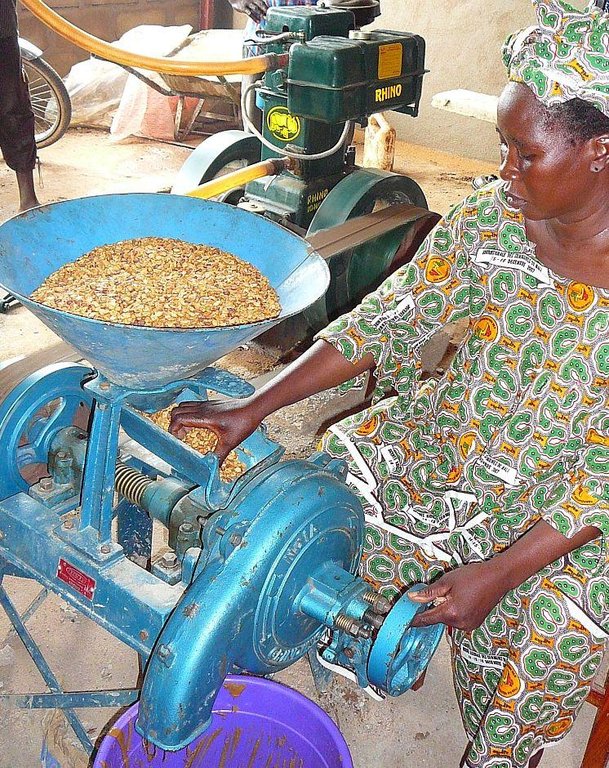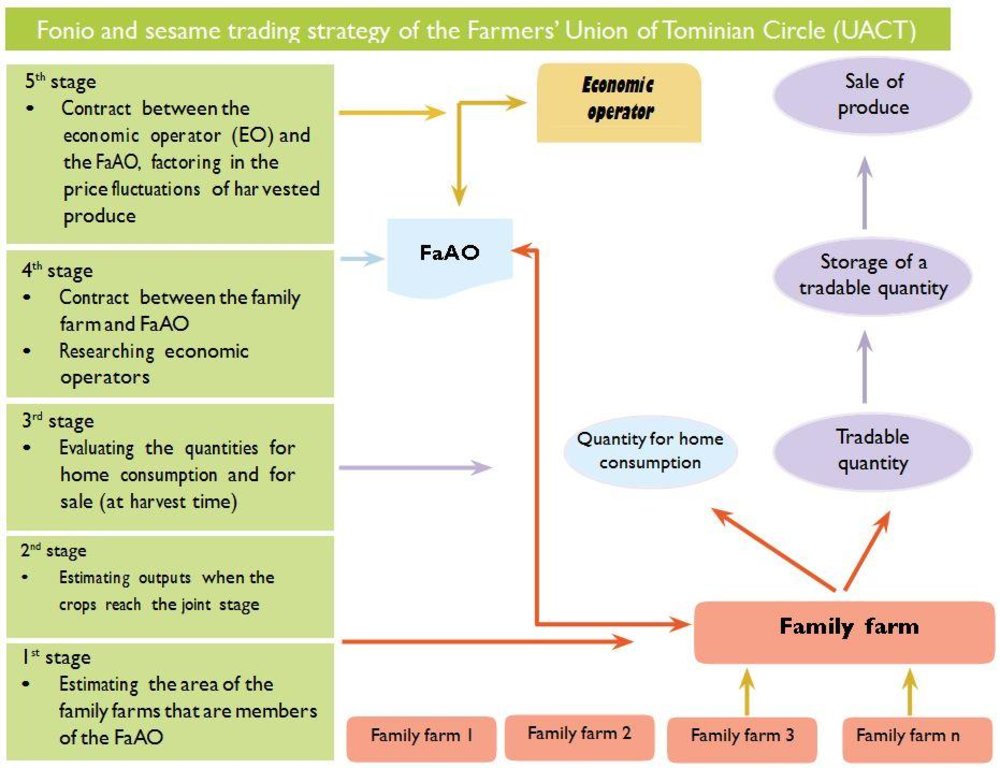Bulk sales approach for farmer apex organisations (FaAO) [Мали]
- Создание:
- Обновить:
- Составитель: Dieter Nill
- Редактор: –
- Рецензент: Laura Ebneter
Approche de commercialisation groupée par des organisations paysannes faitières (OPF))
approaches_2510 - Мали
Просмотреть разделы
Развернуть все Свернуть все1. Общая информация
1.2 Контактные данные специалистов и организаций, участвующих в описании и оценке Подхода
Специалист по УЗП:
Dacko Maïga Rosaline
rosaline.dacko@helvetas.org
HELVETAS - Swiss Intercooperation
Мали
Специалист по УЗП:
Keita Lassana
lassana.keita@helvetas.org
HELVETAS - Swiss Intercooperation
Мали
Специалист по УЗП:
Guindo Idrissa
idrissa.guindo@helvetas.org
HELVETAS - Swiss Intercooperation
Мали
Название организации (-ий), содействовавших документированию/оценке Подхода (если применимо)
HELVETAS (Swiss Intercooperation)Название организации (-ий), содействовавших документированию/оценке Подхода (если применимо)
Deutsche Gesellschaft für Internationale Zusammenarbeit (GIZ) GmbH (GIZ) - Германия1.3 Условия, регламентирующие использование собранных ВОКАТ данных
Когда были собраны данные (на местах)?
01/07/2012
Составитель и ответственный/-ые специалист(-ы) согласны с условиями, регламентирующими использование собранных ВОКАТ данных:
Да
2. Описание Подхода УЗП
2.1 Краткое описание Подхода
Improve the income of family farms by setting up an organized trade mechanism that factors in market price fluctuations.
2.2 Подробное описание Подхода
Подробное описание Подхода:
The objective of the practice is to improve the income of family farms by setting up an organized trade mechanism that factors in market price fluctuations. Structuring trade in this way puts producers in a stronger position in their value chains.
The FaAOs’ approach to trade is based, on the one hand, on purchase agreements for preservable produce (cereals, sesame, etc.) between the FaAO and its producers and, on the other, on sales contracts with one or several market operators/suppliers. The practice enables producers to sell their produce after the harvest at an attractive price, depending on market fluctuations. For the operator, it means a large quantity can be purchased over time, without the need for mobilising major pre-financing resources. As the intermediary, the FaAO benefits from a profit margin and charges levied on transactions.
Stages of implementation: 1) Estimating the areas of family farms that are members of the FaAO: Together with its producers, the FaAO calculates sown areas (of rice, for example) fairly speculatively, providing the first estimates of future outputs. 2) Estimating outputs: Prior to harvesting, the initial estimates made in stage 1 are further refined through crop inspections. 3) Evaluating the quantities for home consumption and for sale: After the harvest, FaAO producers assess what part of their output will be retained for home consumption and what will be sold. 4) Contracting between the family farms and FaAO: The FaAO enters into a contract with the producers for the part to be sold. 5) Contracting between the economic operator and FaAO: Research into economic operators; At a consultation day involving producers, FaAO and operators, a contract is negotiated between FaAO and the operators, who will factor in price increases up to the lean period. Operation: Introducing this approach requires a robust FaAO or family farm, a market analysis and good quality produce. The portion of the output for sale is transferred to the FaAO storage facility. The operator draws down this produce over an extended period. The price for each consignment varies according to the market rate prevailing at the time the produce is drawn down.
Producers provide, process and pack the produce, and enter into a contract with FaAO. The apex organisation researches economic operators, negotiates the sales contract on behalf of the economic operators, stores the produce, monitors sales and manages rebates. Operators draw down produce in line with the terms of the sales contract, and make payments accordingly. Support partners deliver training, provide advisory support and foster contacts.
2.3 Фотографии, иллюстрирующие Подход
2.5 Страна/ регион/ место, где применялся Подход
Страна:
Мали
Административная единица (Район/Область):
Mali
Более точная привязка места:
Ségou, Sikasso
2.6 Даты начала и окончания реализации Подхода
Год начала реализации:
2008
2.7 Тип Подхода
- в рамках проекта/ программы
2.8 Каковы цели/ задачи Подхода
The objective of the practice is to improve the income of family farms by setting up an organized trade mechanism that factors in market price fluctuations. Structuring trade in this way puts producers in a stronger position in their value chains.
The SLM Approach addressed the following problems: low income of family farms, market price fluctuations
2.9 Условия содействующие применению Технологии/ Технологий в рамках Подхода или затрудняющие его
Наличие/ доступность финансовых ресурсов и услуг
- затрудняют
low income of family farms
Treatment through the SLM Approach: setting up an organized trade mechanism that factors in market price fluctuations; purchase agreements for preservable produce (cereals, sesame, etc.) between the FaAO and its producers and sales contracts with one or several market operators/suppliers.
3. Участие и распределение ролей заинтересованных сторон
3.1 Заинтересованные стороны, участвующие в реализации Подхода и их роли
- местные землепользователи/ местные сообщества
- эксперты по УЗП/ сельскому хозяйству
- общественные организации
- местные власти
- государственные власти (отвечающие за планирование или принятие решений)
3.2 Участие местных землепользователей/ местных сообществ на разных стадиях реализации Подхода
| Участие местных землепользователей/ местных сообществ | Перечислите участников и опишите их вовлеченность | |
|---|---|---|
| инициирование/ мотивация | пассивное | |
| планирование | интерактивное | |
| выполнение | интерактивное | |
| мониторинг/ оценка | интерактивное | |
| Research | пассивное |
3.3 Схема реализации (если имеется)
3.4 Принятие решений по выбору Технологии/ Технологий УЗП
Укажите, кто принимал решение по выбору применяемой Технологии/ Технологий:
- преимущественно специалисты по УЗП после консультаций с землепользователями
Поясните:
Decisions on the method of implementing the SLM Technology were made by mainly by SLM specialists with consultation of land users
4. Техническая поддержка, повышение компетенций и управление знаниями
4.1 Повышение компетенций/ обучение
Проводилось ли обучение землепользователей/ других заинтересованных лиц?
Да
Укажите, кто проходил обучение:
- землепользователи
Тип обучения:
- в ходе работы
- обмен опытом между фермерами
- общие собрания
Рассматриваемые темы:
Support partners deliver training, provide advisory support and foster contacts.
4.3 Институциональная (организационная) поддержка
В ходе реализации Подхода были ли организованы новые институциональные структуры или поддержаны уже существующие?
- да, существенно
Укажите уровень, на котором структуры были укреплены или вновь созданы:
- местные
Укажите тип поддержки:
- финансовая
Подробнее:
Improve the income of family farms by setting up an organized trade mechanism that factors in market price fluctuations. Structuring trade in this way puts producers in a stronger position in their value chains.
4.4 Мониторинг и оценка
Являются ли мониторинг и оценка частью Подхода?
Да
Комментарии:
socio-cultural aspects were ad hoc monitored by project staff, land users through observations
economic / production aspects were regular monitored by project staff through measurements
management of Approach aspects were ad hoc monitored by project staff through observations
There were no changes in the Approach as a result of monitoring and evaluation
There were no changes in the Technology as a result of monitoring and evaluation
4.5 Научные исследования
Были ли научные исследования частью Подхода?
Да
Укажите темы исследований:
- социология
- экономика / маркетинг
5. Финансирование и внешняя материальная поддержка
5.1 Годовой бюджет мероприятий по УЗП в рамках Подхода
Комментарий (например, основные источники финансирования/ ключевые доноры):
Approach costs were met by the following donors: international non-government: 100.0%
5.2 Финансирование и внешняя материальная поддержка, предоставляемая землепользователям
Предоставлялась ли землепользователям финансовая/ материальная поддержка для применения Технологии /Технологий?
Нет
5.4 Кредитование
Предоставлялись ли в рамках Подхода кредиты на мероприятия УЗП?
Нет
6. Анализ влияния и заключительные положения
6.1 Влияние Подхода
Сумел ли Подход помочь землепользователям внедрить и поддерживать технологии УЗП?
- Нет
- Да, немного
- Да, умеренно
- Да, существенно
The approach offers producers greater opportunities to access enhanced seeds and inputs (credibility among service providers).
Сумел ли Подход расширить возможности социально и экономически уязвимых групп?
- Нет
- Да, немного
- Да, умеренно
- Да, существенно
When prices become more lucrative, producers are less inclined to sell off their harvest; the risk of slumps in prices is minimal.
Did other land users / projects adopt the Approach?
- Нет
- Да, немного
- Да, умеренно
- Да, существенно
Implementation locations: Ségou and Sikasso. 12,750 beneficiaries are applying this approach in 14 apex organisations.
Did the Approach lead to improved livelihoods / human well-being?
- Нет
- Да, немного
- Да, умеренно
- Да, существенно
Puts producers in a stronger position in their value chains. Incomes are stabilised, which improves living conditions and social cohesion. Communities are better able to pay taxes and more receptive to formalised contracts.
Did the Approach help to alleviate poverty?
- Нет
- Да, немного
- Да, умеренно
- Да, существенно
6.2 Основные причины, побуждающие землепользователей внедрять УЗП
- рост продуктивности
- рост прибыли (доходности) и рентабельности
6.3 Долгосрочная устойчивость мероприятий в рамках Подхода
Могут ли землепользователи самостоятельно (без внешней поддержки) продолжать применение того, что было реализовано в рамках Подхода?
- нет уверенности
6.4 Сильные стороны/ преимущества Подхода
| Сильные стороны/ преимущества/ возможности по мнению составителя или других ключевых специалистов |
|---|
| Bank loans guaranteed as a result of retained stocks and management tools |
|
Guaranteed revenues for small-scale producers |
| Improved post-harvest management |
| As revenues grow, producers seek to maximise their cropping schedules in order to earn more money. The approach offers producers greater opportunities to access enhanced seeds and inputs (credibility among service providers). When prices become more lucrative, producers are less inclined to sell off their harvest; the risk of slumps in prices is minimal. Incomes are stabilised, which improves living conditions and social cohesion. Communities are better able to pay taxes and more receptive to formalised contracts. |
| Price stabilisation (to prevent produce from being sold-off) and improved producer incomes (How to sustain/ enhance this strength: A thorough market analysis must be conducted to enable market price fluctuations to be accurately predicted and the best times for sale to be pinpointed. Client relationships must be professional and contractual. Informal commitments often fall through. The FaAO must have committed and business-minded leaders. It is wise to stay vigilant when it comes to the governance of these organisations, as they can fall prey to corrupt practices and the embezzlement of collective funds.) |
7. Справочные материалы и ссылки
7.1 Методы сбора/источники информации
- выезды на места, полевые обследования
- опросы землепользователей
7.2 Ссылки на опубликованные материалы
Название, автор, год публикации, ISBN:
Manual of Good Practices in Small Scale Irrigation in the Sahel. Experiences from Mali. Published by GIZ in 2014.
Где опубликовано? Стоимость?
http://star-www.giz.de/starweb/giz/pub/servlet.starweb
Название, автор, год публикации, ISBN:
HELVETAS Swiss Intercooperation: annual report 2010-2011 for the San Hub (Pôle de San)
Название, автор, год публикации, ISBN:
HELVETAS Swiss Intercooperation (2013): JIGIYA programme evaluation report
Ссылки и модули
Развернуть все Свернуть всеСсылки
Нет ссылок
Модули
Нет модулей





